How to estimate a total population size of a rare plant and why it matters
Conservation of rare species involves knowing where they are found and how many individuals are in a population. If a species can only survive in certain habitats, then any changes to that habitat can drive a species to extinction. Similarly, as the population size decreases, chance events can have an increasing impact.
A rare cactus found only in western Colorado has recently been recommended for delisting from the Endangered Species Act because we know more about its natural history now than we did at the time of listing. We have a clearer understanding of how much genetic diversity is present within and among populations (enough to propose naming a new species). We know more about how survival, growth and reproductive rates drive population size (pretty stable). Lastly, and maybe most importantly to this decision, we have better estimates of the number of individuals in each population (many more than previously documented). Estimates of the minimum cactus abundance provide a snapshot of the current status and show that population sizes are large enough to persist through random fluctuations in germination and reproduction.

Near Grand Junction, ant in cactus flower.
However, future conservation decisions are also based on trends. Ideally, we would know how many individuals there are, a census of an entire population and how the total population size changes over time so we can determine if or when this species’ listing status might need to be revisited and if conservation actions are needed. We can and will infer population trends from the growth, survival and reproductive rates sampled from plots within populations. Our data about population trends come from representative plots scattered throughout the species’ range. Because of the purposeful placement of plots, we are limited in our ability to project plant density outside of plots.
Unlike animals, most plants can be found in the same location from year to year, and we are able to count all the individuals we see. Counting every individual is nearly impossible due to our inability to comb over all suitable and known habitat. Even if we could, we would likely miss many seedlings or vegetative individuals, so our counts are always estimates of the true population size. To get population counts that are comparable from year to year, we can use a plotless sampling design to estimate the total population size within defined habitats and a model for how many we individuals we miss as we survey.

April LeBaron and Grace Gardner, students from Colorado Mesa University counting Sclerocactus glaucus near DeBeque, Colorado.
Last summer, supported by our summer internship program with two students from Colorado Mesa University, we tested a distance sampling method commonly used for animal species. With help from a spectacular graduate student from Regis University, we are using this preliminary data to determine an efficient sampling design to estimate the total population size across the entire range of the species. This summer we’ll test our design. If successful, we could use this method to get more accurate population counts to estimate abundance and population trends for more of our rare and threatened species.
Add new comment